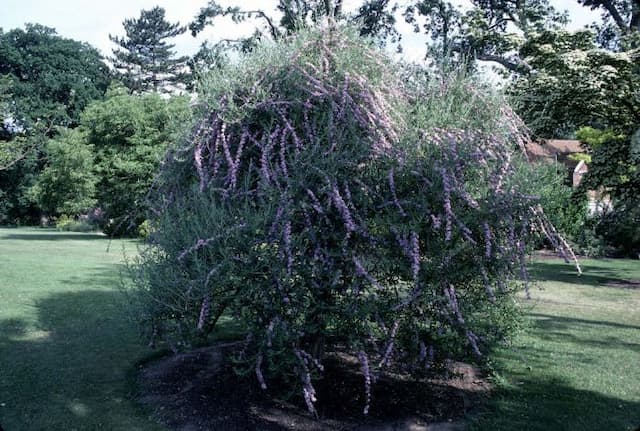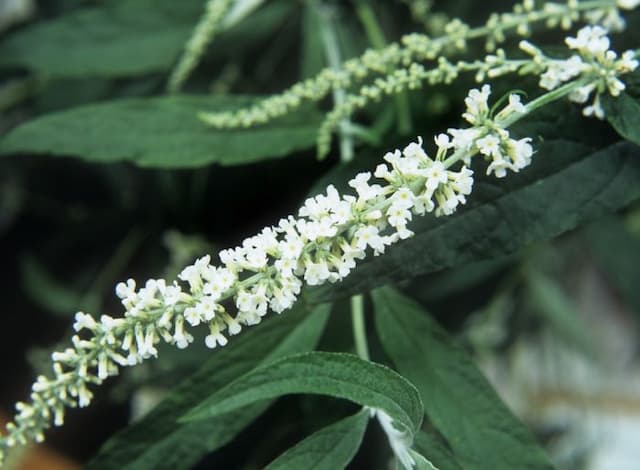Water Figwort Scrophularia auriculata 'Variegata' (v)

ABOUT
Scrophularia auriculata 'Variegata', also commonly known as variegated water figwort, is a striking plant known for its ornamental features. This plant bears distinct foliage that immediately catches the eye. The leaves are uniquely patterned with green and cream or white variegation, adding a splash of brightness to any garden space. Each leaf is irregularly edged or mottled with these lighter colors, contrasting sharply against the darker green background. The leaves are generally oval or heart-shaped with pointed tips and have a slightly wrinkled or crinkled surface that adds textural interest. They are arranged oppositely along the stems, creating a balanced and symmetrical appearance. During its blooming period, variegated water figwort produces small, inconspicuous reddish-brown to purple flowers. These blooms may not be the main attraction in comparison to the showy foliage but do provide an additional layer of visual interest in the garden. The stems of Scrophularia auriculata 'Variegata' often appear somewhat squared, giving the plant a sturdy look. With its variegated leaves, it brings a light and lively touch to shaded areas, acting as an excellent contrast plant amongst other garden greens. While flowering, its subtle blossoms may attract beneficial insects, adding to the ecosystem services it provides beyond its aesthetic appeal. Overall, variegated water figwort is a charming and attractive addition to a garden that also enjoys a degree of shade.
About this plant
 Names
NamesFamily
Scrophulariaceae
Synonyms
Water Figwort, Variegated Water Figwort
Common names
Scrophularia auriculata 'Variegata'
 Toxicity
ToxicityTo humans
The plant commonly known as Water Figwort is not widely recognized as highly toxic to humans, but it may contain saponins and other compounds that can be mildly irritating or toxic. If ingested, especially in large amounts, it can cause gastrointestinal upset, including symptoms like nausea, vomiting, and diarrhea. While poisoning from Water Figwort is not commonly reported, it is generally advised to avoid consuming any part of this plant.
To pets
Water Figwort is also not widely recognized as highly toxic to pets, but, similar to its effects on humans, it may contain compounds that can irritate the gastrointestinal system if ingested. Symptoms in pets may include vomiting, diarrhea, and possible abdominal discomfort. While it is uncommon for pets to severely poison themselves with Water Figwort, it is best to prevent ingestion and consult a veterinarian if your pet consumes any part of the plant.
 Characteristics
CharacteristicsLife cycle
Perennials
Foliage type
Deciduous
Color of leaves
Variegated
Flower color
Green
Height
3 feet (0.91 meters)
Spread
2 feet (0.61 meters)
Plant type
Herb
Hardiness zones
5
Native area
Europe
Benefits
 General Benefits
General Benefits- Ornamental appeal: Scrophularia auriculata 'Variegata', commonly known as water figwort, features variegated leaves that add visual interest to garden spaces.
- Habitat for wildlife: Water figwort provides shelter and habitat for various insects, including bees and butterflies, which are attracted to its flowers.
- Drought tolerance: Once established, it has a good level of drought resistance, making it suitable for gardens in drier climates or where water conservation is necessary.
- Low maintenance: Water figwort requires minimal care once established, making it an ideal plant for gardeners who prefer a low-maintenance landscape.
- Shade tolerance: This plant can grow in shaded areas where other plants might struggle, providing gardeners with more planting options.
- Soil adaptability: Water figwort can thrive in a range of soil types, from loamy to clay, as long as the soil is well-draining.
- Cold hardiness: The plant is relatively hardy and can survive in cooler climates, making it suitable for a variety of garden zones.
 Medical Properties
Medical PropertiesThis plant is not used for medical purposes.
 Air-purifying Qualities
Air-purifying QualitiesThis plant is not specifically known for air purifying qualities.
 Other Uses
Other Uses- Water's edge planting: Due to its affinity for moisture, Scrophularia auriculata 'Variegata' is suitable for planting at the edge of ponds or streams where it can help stabilize the bank.
- Insect attraction: This plant can attract beneficial insects to the garden, such as bees and butterflies, which help with pollination.
- Dye production: Historically, some species in the Scrophularia genus have been used for creating natural dyes, although this is not a common use for Scrophularia auriculata 'Variegata' specifically.
- Educational tool: Can be used in educational settings to teach students about variegated foliage and how it can occur in nature.
- Companion planting: It may serve as a companion plant in the garden, potentially deterring pests away from more valuable plants.
- Shade gardening: With its tolerance for partial shade, it can offer interesting foliage and texture to shaded garden spots.
- Seasonal interest: Even when not in flower, the plant offers visual interest with its distinctive variegated leaves, especially in the spring and summer months.
- Art and photography: Can serve as a subject for art and photography, providing a unique variegated pattern and structure to capture on canvas or film.
- Wildlife habitat: The plant can serve as shelter for small wildlife, offering cover for amphibians like frogs near water bodies.
- Ecological studies: Scrophularia auriculata 'Variegata' may be used in ecological studies or conservation efforts to understand the plant’s role in a particular habitat.
Interesting Facts
 Feng Shui
Feng ShuiThe Water Figwort is not used in Feng Shui practice.
 Zodiac Sign Compitability
Zodiac Sign CompitabilityThe Water Figwort is not used in astrology practice.
 Plant Symbolism
Plant Symbolism- Healing: Scrophularia auriculata, commonly known as water figwort, has been used in traditional medicine to treat various ailments, symbolizing healing and recovery.
- Protection: In some cultures, figwort was believed to protect against evil spirits, representing a shield against negativity and harm.
- Adaptability: With its ability to grow in a variety of conditions, water figwort embodies adaptability and resilience in the face of challenges.
 Water
WaterThe Water Betony, or Scrophularia auriculata 'Variegata', should be watered deeply once the top inch of soil feels dry to the touch. This generally means watering approximately once a week, but this can vary based on climate and environmental conditions. It's important to avoid overwatering, as this can lead to root rot. During the growing season, it might be necessary to water more frequently, especially if the plant is located in a warmer, sunny spot. A rough guideline would be to provide about one gallon of water per plant every 7 to 10 days, adjusting based on rainfall and temperature.
 Light
LightWater Betony thrives best in partial shade to full sun. The ideal location for Scrophularia auriculata 'Variegata' would be a spot where it receives morning sunlight and is protected from the intense heat of the afternoon sun. However, it can also tolerate a spot with dappled sunlight throughout the day.
 Temperature
TemperatureScrophularia auriculata 'Variegata', commonly known as Water Betony, can survive in temperatures ranging from about 25°F to upwards of 85°F. The ideal temperature for promoting growth is between 60°F and 75°F. It's crucial to protect the plant from frost, which can damage the foliage and stems.
 Pruning
PruningPrune Water Betony in late winter or early spring to remove any dead or damaged stems and to shape the plant. This encourages healthy, new growth and helps maintain an attractive appearance. Pruning can be done annually, or as needed, to control the size of the plant. The best time for pruning is when the plant is dormant, just before the new spring growth begins.
 Cleaning
CleaningAs needed
 Soil
SoilWater Figwort prefers well-draining soil rich in organic matter with a soil pH slightly acidic to neutral, around 6.0 to 7.0. A mix of loam, compost, and sand or perlite can provide the ideal growing conditions.
 Repotting
RepottingWater Figwort should be repotted every 2 to 3 years, or when it outgrows its current pot, to refresh the soil and encourage continued growth.
 Humidity & Misting
Humidity & MistingWater Figwort thrives best in moderate humidity levels, neither too dry nor too humid, keeping it close to typical room humidity is suitable.
 Suitable locations
Suitable locationsIndoor
Place Water Figwort in bright indirect light with moderate watering.
Outdoor
Grow Water Figwort in partial shade with moist, well-drained soil.
Hardiness zone
4-9 USDA
 Life cycle
Life cycleScrophularia auriculata 'Variegata', commonly known as Water Figwort, starts its life as a seed, which upon germination, emerges as a seedling typically in the spring. As it grows into a young plant, it develops a rosette of variegated leaves, which are often green with creamy-white edges. The plant matures into its vegetative stage, where it forms a bushy structure and further develops its characteristic square stems and opposite leaves. During the flowering stage in summer, Water Figwort produces small, reddish-brown to greenish flowers, which are interesting yet not particularly showy and grow in loose panicles. After pollination by insects, the plant produces small capsule-like fruits containing numerous seeds, completing its reproductive cycle. Finally, the plant may enter dormancy in the colder months, with its above-ground parts dying back, while the root system survives to sprout again the following season.
 Propogation
PropogationPropogation time
Spring-Early summer
Propogation: Water figwort, as Scrophularia auriculata 'Variegata' is commonly known, is typically propagated by seed or by division. The most popular method of propagation for this plant is by division, which is most suitably done in spring or early autumn. To propagate by division, carefully dig up the parent plant, ensuring a good amount of root and crown is intact. Gently separate the plant into smaller sections, each with several shoots and an adequate portion of the root system. Replant these divisions immediately at the same depth they were growing at before, spacing them about 12 inches (approximately 30 centimeters) apart to give them room to grow. Water the new divisions thoroughly after planting to help establish them. This method is straightforward and helps to maintain the variegation of the foliage, which can be lost when propagating by seed.


![Butterfly bush [Buzz Magenta]](/_next/image?url=https%3A%2F%2Fplants-admin.emdemapps.com%2Fimages%2Fplants%2F%2Fimages%2F604b58e34126b.png&w=640&q=75)
![Butterfly bush [Peacock]](/_next/image?url=https%3A%2F%2Fplants-admin.emdemapps.com%2Fimages%2Fplants%2F%2Fimages%2F604b634800554.png&w=640&q=75)




